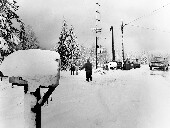
THURSDAY, Jan. 23, 2014 (HealthDay News) — As another blast of Arctic air sends millions of Americans into a prolonged deep freeze, doctors are offering advice on dealing with dangerously frigid temperatures.
“It’s best to limit your outdoor activity as much as possible, since prolonged exposure can lead to frostbite and hypothermia,” Dr. John Marshall, chair of emergency medicine at Maimonides Medical Center in New York City, told HealthDay. “Both of these conditions can become serious, and even life-threatening, if untreated.”
On Wednesday, sub-freezing temperatures stretched as far south as Texas. But the end is not near: By early next week, many regions of the United States will see temperatures plunge for a third time this winter, falling 15 to 30 degrees below normal, The Weather Channel reported.
And more snow is expected in some parts of the Midwest, Northeast and mid-Atlantic region in the coming days, the weather service added.
When temperatures drop low, there are many simple safeguards you can take to prevent severe injury, Marshall said.
They include:
- Dress warmly. Layering your clothing will provide the best insulation and retain body heat. Wearing a non-permeable outer layer will minimize the effects of strong winds.
- Protect your extremities. Hands and feet are at greater risk of frostbite because body heat is naturally reserved in the torso to protect vital organs. So wear an extra pair of socks, and choose mittens because fingers stay warmer when next to each other.
- Wear a hat. You lose about 30 percent of your body’s heat from your head. Particularly good are hats that cover the ears and nose.
- Wear properly fitted winter boots. Boots that are too tight can limit or cut off circulation to the feet and toes. Also, choose a boot that’s insulated and has treads on the bottom for traction on ice and snow.
- Stay hydrated. The body uses a lot of energy to keep itself warm. Drinking plenty of fluids is important because your body will need frequent replenishing when fighting off the cold.
- Get out of wet clothing as soon as possible.
When you’re out in the cold, the part of your skin that’s exposed will chill rapidly, experts say. This can lead to decreased blood flow and your body temperature can drop, leaving you susceptible to frostbite and hypothermia.
According to Marshall, frostbite “starts with tingling or stinging sensations. The face, fingers, and toes are the first body parts to be affected. Then muscles and other tissues can become numb.” Additional signs of frostbite include redness and pain in the skin. This can lead to discolored and numb skin, he said.
Hypothermia, which often goes hand-in-hand with frostbite, can affect the brain, making it harder to think clearly. Warning signs of hypothermia include shivering, confusion, slurred speech and drowsiness, Marshall said.
“If any of these symptoms become noticeable, you should protect the exposed skin, get to a warm place and seek immediate medical treatment,” he said.
Some people are especially vulnerable to the dangers of cold weather. They include the elderly, those with diabetes, heart, or circulatory problems, and people who use alcohol, caffeine or other drugs that inhibit the body’s ability to protect itself against the cold.
Dr. Robert Glatter, an emergency medicine physician at Lenox Hill Hospital in New York City, said there are several key factors that determine how long people can endure extremely cold temperatures. Those factors are wind speed, how well a person is dressed, and if their skin is wet or moist.
Dressing in layers may help. Use the “three-layers guideline” to provide more effective insulation. The first layer helps to drain moisture or sweat. The second layer serves as insulation, while a third sturdy outer layer can help to block out the cold, Glatter said.
If you think you or another person is suffering from frostbite, get to a health-care professional as fast as possible or call 911. If you can’t get immediate medical help for at least two hours, re-warm the affected area with warm water. And drink warm, non-alcoholic fluids, Glatter said.
Cindy Lord is director of the physician assistant program at the Frank H. Netter MD School of Medicine at Quinnipiac University in Hamden, Conn. She likes to use the acronym C.O.L.D. when advising people on dealing with the cold.
- Cover up: Wear a hat or other protective covering to prevent body heat loss from your head, face and neck.
- Overexertion: Avoid activities that cause you to sweat a lot. This can cause you to lose body heat more quickly.
- Layers: Dress in layers. Wear loose-fitting, layered, lightweight clothing. Wool, silk or polypropylene inner layers hold body heat better than cotton.
- Dry: Get out of wet clothing as soon as possible. Keep your hands and feet dry.
And for those who will have to venture out to shovel snow from driveways and sidewalks in the coming days, Lisa Hoglund, a physical therapy professor at University of the Sciences in Philadelphia, offered this advice:
- Warm up before heading out by jogging in place or stretching.
- Use a shovel that is designed to be lighter and easier on your back to use.
- Use the right technique when shoveling, pushing the snow more than lifting it, and bending with your knees before lifting.
- Shovel smaller amounts of snow at a time.
- Take breaks every 15 minutes or so, and stop shoveling if you feel pain, shortness of breath or chest discomfort.
More information
For more on protecting yourself in the cold, visit the U.S. Centers for Disease Control and Prevention.
Copyright © 2025 HealthDay. All rights reserved.

